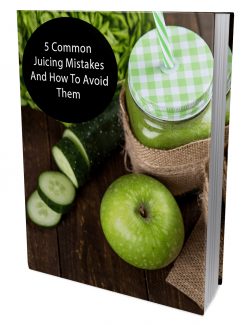 License Type: Master Resell Rights
License Type: Master Resell Rights  File Type: ZIP
File Type: ZIP
 SKU: 64137
SKU: 64137  Shipping: Online Download
Shipping: Online Download
Sample Content Preview
Introduction
Juicing has become very popular lately. Hardly a day goes by when we don’t hear some celebrity trumpeting his or her juice cleanse. It’s not the celebrity endorsements, however, that are important. The fact is, juicing can make a serious difference in how you feel.
The glitterati aren’t the only ones benefiting from juicing. Athletes, Olympians, and weekend warriors are improving their performance by adding fresh juice to their diet. Green in your diet builds red blood cells in your body, which leads to higher endurance and better athletic performance. Athletes need more than juice to stay in the game, but healthy juices are seen by many as an additional boost that can make or break athletic success.
Juicing does have some amazing benefits. It can provide an abundance of vitamins, minerals in concentrate form that you wouldn’t get otherwise, thus increasing your energy and general health. Fruit and vegetable juices also deliver antioxidants that can prevent serious diseases. Juicing can provide you with more energy, protect you from common toxins, and make your skin glow. The fact is, you should definitely be juicing. But you should be juicing the right way. Juicing works best as a part of a healthy lifestyle, not a quick fix to health problems.
It’s been known for a long time that fruits and vegetables are necessary for a healthy diet and in the prevention of chronic diseases. But getting those recommended five to six servings every day isn’t easy, if not close to impossible. That’s an entire bag of apples!
Many of us are lucky to munch on two pieces of fruit a day. Most of us are getting less than that. That’s where juicing can come to the rescue. By condensing four to five helpings of produce into a single glass of juice, you’re greatly increasing those needed nutrients on a manageable level.
But many people rely on juicing alone as the answer to their health woes, and that is a huge mistake. Juice to supplement your healthy diet, not replace it. A diet of just juice, regardless of how nutrient-packed, can lead to extreme hunger, which can cause severe binging.
If juicing is approached incorrectly, it can cause health problems instead of preventing them. Before you start juicing and enjoy all the great benefits, you need to be aware of the pitfalls and mistakes people can make when starting to juice. Yes, juicing is better than not juicing. Your body craves those fresh fruits and vegetables. But let’s start off right and do it correctly for maximum juicing benefits.
Start juicing slowly, with one glass of concentrated juice each day, then gradually add a second, then a third glass. This will get your body used to the additional boost of nutrients. If you start in full-blown, your body can release toxins into the bloodstream too quickly. Start your juicing regimen gradually, and allow your body to adapt in a healthier way. This is especially important for someone who is used to a bad diet and has accumulated an abundance of toxins. Too much of a good thing too quickly can cause your body to protest. Imagine starting a new exercise regime by running a marathon!
The best way to get started is with four to six ounces of concentrated juice daily for up to a week. Then just add four ounces each subsequent week until you reach 32 ounces, which should be enough to provide plenty of needed nutrition when incorporated into a healthy diet.
This book is designed to help you avoid the serious pitfalls made by many beginning and eager juicers. Juicing done right can improve your health in so many ways.
Drinking too much Sugar
Juicing provides plenty of nutrients fast and directly into your bloodstream. It can act very quickly because it is absorbed directly into the blood stream instead of digestive tract, so you feel the effects immediately. One big mistake people make when starting to juice is using too many fruits and too few vegetables. Yes, that freshly squeezed orange or apple sure tastes great. And you’re getting an instant boost of energy. What you are also getting is a large amount of fruit sugar called fructose.
We all know the hazards of too much sugar. It can lead to obesity, diabetes and heart diseases. That fact doesn’t change when the sugar comes from an excess of healthy fruits. The body will process most sugars the same way, whether they come from a cake or an apple.
The best ratio of vegetables to fruit when juicing is 80/20. That provides you with plenty of sweetness as you enjoy the health benefits of vegetables you might not otherwise eat. Many people try to improve the taste of their green juices by adding too many fruits. What they are adding, instead, is too much sugar. This will cause your blood sugar level to rise to dangerously high levels.
Sweet fruit juices can be addictive, like any other sugary product. While juicers may bask in their healthy habits, all that fructose can lead to serious obesity. Consider the following: one or two apples a day are a great health benefit. When you start juicing six, seven or more for one glass of juice, you’re overloading your body with many additional calories without the fiber necessary for slow digestion. The body turns fructose into FFAs (free fatty acids), most of which gets stored in the liver as fat. This can easily turn into Type 2 diabetes. If you consume 120 calories in fructose form, 40 of those calories remain in your liver as fatty cells.
A glass of juice in the morning can start your day off right. If you continue juicing fruit throughout the day, you are risking serious weight gain. For the remainder of the day, be sure to juice plenty of green, leafy vegetables and add just a bit of fruit as a sweetener. The best juices are green in color.
Fruits with a heavy sugar content are plums, pineapple, oranges, kiwi, and pears.
Fruits with a low sugar content are berries, lemons, and rhubarb.
Even vegetables aren’t immune to high sugar content. Take a 16 oz. glass of delicious carrot juice. It contains 41 grams of sugar! And carrots aren’t even the most sugary vegetable. A 16 oz. glass of beet juice contains 64 grams of sugar.
This certainly doesn’t mean you shouldn’t be juicing. It means you need to become an educated juicer. The best vegetables for juicing will always be green. These are the ones highest in nutrients and lowest in sugar. Think cucumbers, broccoli, cabbage, celery, kale, spinach, collard greens and Swiss chard. These greens should form the basis of most of your juices. You can basically consume an unlimited amount of them.
Vegetables with the highest sugar content tend to be root vegetables such as yams, beets, carrots and potatoes. These vegetables do have other, obvious health benefits, so don’t omit them from your diet altogether.
All vegetables are good for you. This list is merely a juicing guide when you are watching your sugar intake.
If you’re juicing, eating some whole, fresh fruit in addition to the juice will provide you with the fiber necessary to help your body process all that additional sugar. Therefore, consider fruit juices an enhancement to fresh fruit, not a replacement.
- License: Master Resell Rights
- Category:Ebooks
- Tags:2021 Ebooks With Audio Master Resale Rights








